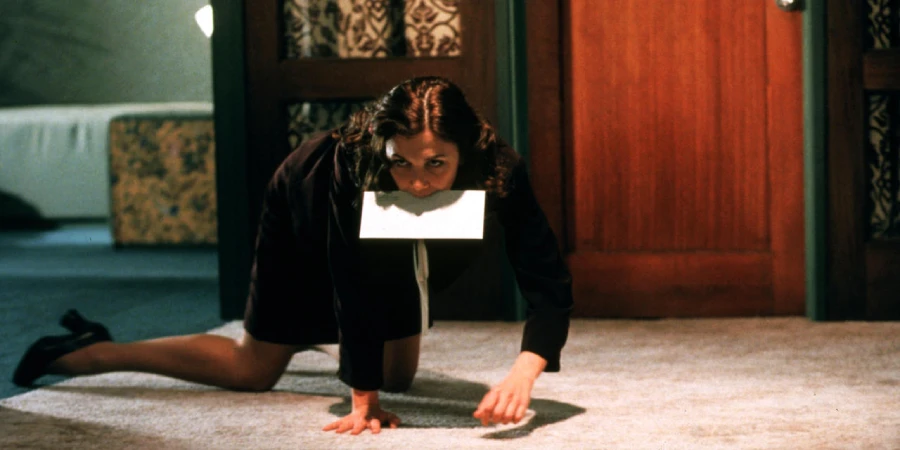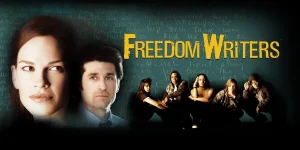Secretary (2002) is a provocative romantic drama directed by Steven Shainberg and written by Erin Cressida Wilson, based on a short story by Mary Gaitskill. It’s a film that explores themes of BDSM, self-discovery, emotional intimacy, and empowerment—wrapped in an offbeat love story. It walks a delicate line between dark humor and sincere emotion, and it has earned a cult following for its unique tone and fearless performances.
Table of Contents
ToggleDetailed Summary
Introduction: Lee’s Fragile World
The story follows Lee Holloway (played by Maggie Gyllenhaal), a young woman recently released from a mental institution after a suicide attempt. She returns to her dysfunctional family, where emotional neglect and a troubled home environment have shaped much of her inner turmoil. Struggling with self-harm, she quietly resumes her old habits, hiding them from her family. Despite having no previous experience, Lee decides to apply for a job as a legal secretary.
Meeting Mr. Grey
Lee lands a job working for the enigmatic E. Edward Grey (played by James Spader), a highly particular, emotionally repressed attorney with obsessive tendencies. From the start, their dynamic is laced with tension—he is stern and demanding, while she is deferential and eager to please. However, Lee’s submissive personality and Grey’s dominant nature quickly develop into something far more intimate than a traditional office relationship.
The Emergence of BDSM
Their working relationship becomes sexually charged after Mr. Grey punishes Lee for typing errors by spanking her. What begins as a disciplinary act evolves into a mutually gratifying BDSM dynamic, though it is never labeled as such within the film. Lee thrives under Grey’s structure and attention—her self-harming stops, and she begins to feel more empowered and self-aware. At the same time, Grey struggles with his feelings, ashamed of his desires and the unconventional relationship he’s fostering.
Conflict and Withdrawal
Grey, realizing the intensity of their bond and fearing the implications, abruptly ends their sexual dynamic. He becomes cold and distant, instructing Lee to find a different job. Lee is emotionally devastated but outwardly compliant. She begins dating a childhood friend, Peter, and even becomes engaged to him, attempting to fit into a more socially acceptable life.
Movie Ending
The climax of Secretary is as unconventional and bold as the rest of the film. On the day of her wedding to Peter, Lee finally chooses to confront her true desires. She goes to Grey’s office and declares her love for him, asking to resume their dominant-submissive relationship. Grey, still emotionally conflicted, instructs her to sit in his chair, place her hands on the desk, and not move until he returns.
She remains in that position for three days—without food, water, or using the bathroom. Various people (including her fiancé, Peter, her parents, and even news crews) come and go, trying to talk her out of it. But Lee remains firm, proving both her devotion and understanding of her desires. Grey finally returns, bathes and dresses her lovingly, and symbolically accepts her submission by feeding her and carrying her out of the office.
The film ends with the two of them living together as a happily (and unconventionally) matched couple. Lee narrates the ending, affirming her choice and proudly stating that her life is now full of meaning. She still faces challenges, but she has found self-acceptance and fulfillment through her relationship with Grey, on her own terms.
Are There Post-Credits Scenes?
No, Secretary does not have a post-credits scene. Once the narrative ends, so does the film—there are no extra teases or follow-ups after the credits roll.
Type of Movie
Secretary is best described as a romantic drama with strong elements of dark comedy, psychological exploration, and eroticism. It’s also widely acknowledged as one of the first mainstream films to explore BDSM dynamics in a realistic and emotionally resonant way.
Cast
- Maggie Gyllenhaal as Lee Holloway
- James Spader as E. Edward Grey
- Jeremy Davies as Peter
- Lesley Ann Warren as Joan Holloway (Lee’s mother)
- Stephen McHattie as Burt Holloway (Lee’s father)
- Patrick Bauchau as Dr. Twardon
Film Music and Composer
The film’s original score was composed by Angelo Badalamenti, known for his long-time collaborations with David Lynch (Twin Peaks, Blue Velvet). The score blends classical and quirky tones, complementing the film’s emotional fluctuations and its offbeat, darkly romantic atmosphere.
The soundtrack also includes fitting selections like “Chariots Rise” by Lizzie West, used in a climactic moment as Lee waits in Grey’s office chair, adding emotional weight and irony.
Filming Locations
Secretary was primarily shot in Los Angeles, California. The office setting—one of the film’s most important locations—is designed with an almost timeless aesthetic, giving the movie an oddly detached, dreamlike quality. This ambiguity in time and place reflects the characters’ emotional states and makes the story feel both universal and slightly surreal.
Awards and Nominations
Secretary received widespread critical acclaim, particularly for Maggie Gyllenhaal’s breakout performance, which earned her several nominations:
- Golden Globe Nomination for Best Actress in a Motion Picture – Musical or Comedy
- Independent Spirit Award for Best First Screenplay (Erin Cressida Wilson)
- Special Jury Prize for Originality at the Sundance Film Festival
- Boston Society of Film Critics Award for Best Actress – Maggie Gyllenhaal
The film was also a favorite among critics for its unique handling of controversial subject matter.
Behind the Scenes Insights
- Maggie Gyllenhaal took the role because she saw Lee as a woman finding her power, not just someone being dominated.
- James Spader, who has often played eccentric characters, reportedly helped shape Grey’s emotional restraint and internal conflict.
- The spanking scene was filmed with great care and collaboration between the actors to maintain trust and comfort.
- Director Steven Shainberg pushed for a tone that avoided typical Hollywood BDSM clichés, instead focusing on emotional development.
Inspirations and References
The movie is based on the short story “Secretary” by Mary Gaitskill, from her collection Bad Behavior. The film, however, expands and transforms the story significantly—particularly by giving Lee more emotional agency and turning the ending into a romantic, affirming moment rather than a disturbing one.
The film also draws inspiration from 1950s office romance tropes, intentionally twisting them into a modern, subversive narrative.
Alternate Endings and Deleted Scenes
There are no known alternate endings officially released for Secretary, but some deleted or trimmed scenes explored more of Lee’s home life and her background in self-harm. These were cut to keep the narrative focused on the evolving dynamic between Lee and Mr. Grey.
Book Adaptations and Differences
While the film is based on Mary Gaitskill’s short story, there are major differences:
- In the short story, the relationship is far more ambiguous and not romanticized.
- The character of Mr. Grey is colder and more disturbing, with less emotional resolution.
- Lee is more passive and the ending is bleak, lacking the empowerment arc of the film version.
The film turns what was originally a tale of dysfunction into one of mutual understanding and emotional liberation.
Memorable Scenes and Quotes
Key Scenes
- Lee getting her first letter typed perfectly, receiving Grey’s approval.
- The infamous “spanking scene”—a turning point in their relationship.
- Lee walking through town in her wedding dress to reach Grey’s office.
- The three-day desk scene, showcasing her commitment and defiance of societal expectations.
Iconic Quotes
- “We can’t do this 24 hours a day, seven days a week.”
- “Is this what you want, Lee?”
- “I like pain.”
- “My name is Lee Holloway, and I am your secretary.”
Easter Eggs and Hidden Details
- The number of typos Lee makes early in the film subtly decreases as she gains confidence.
- Grey’s name (“E. Edward Grey”) may be a nod to the later Fifty Shades of Grey franchise, although that series came out years later.
- The décor of Grey’s office reflects his inner rigidity—everything perfectly placed and dark-toned.
Trivia
- Maggie Gyllenhaal was 24 during filming and had never done a lead film role before.
- The film was completed in under 30 days on a tight budget of around $4 million.
- It became a cult hit after its theatrical release and remains widely discussed in academic circles on film and sexuality.
- James Spader previously starred in Crash (1996), another film exploring unconventional sexual behavior.
Why Watch?
If you’re interested in movies that challenge social norms, depict complex female characters, and explore non-traditional love stories without judgment or sensationalism, Secretary is a must-watch. It’s bold, emotionally raw, strangely sweet, and surprisingly funny. It also serves as a landmark in how BDSM was presented seriously in mainstream cinema.
Director’s Other Movies
- Fur: An Imaginary Portrait of Diane Arbus (2006)
- Hit Me (1996)
- The Big Time (2002, TV Movie)













